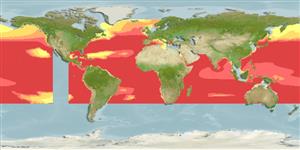>
Stomiiformes (Lightfishes and dragonfishes) >
Sternoptychidae (Marine hatchetfishes) > Maurolicinae
Etymology: Valenciennellus: From Achille Valenciennes 1794-1865; he worked with Duméril, Cuvier and Lacepède since 1815; malacologist, author of a "Histoire naturelle des poissons" (Ref. 45335).
Environment: milieu / climate zone / depth range / distribution range
Ecologia
marinhas batipelágico; não migratória; intervalo de profundidade 100 - 1000 m (Ref. 74511), usually 200 - 400 m (Ref. 4462). Deep-water; 67°N - 34°S, 98°W - 117°W
Worldwide in tropical to temperate waters (Ref. 37039). Eastern Atlantic: scattered records in Iceland, Ireland, Mediterranean Sea, also from Portugal southward to Namibia. Western Atlantic: Gulf of Mexico (Ref. 27768). Northwest Atlantic: Canada (Ref. 5951). Eastern Pacific: California Current region (Ref. 35838). South China Sea (Ref.74511).
Length at first maturity / Tamanho / Peso / Idade
Maturity: Lm ?, range 3 - ? cm
Max length : 3.1 cm SL macho/indeterminado; (Ref. 4462); 3.1 cm SL (female)
Descrição breve
Chaves de identificação | Morfologia | Morfometria
Espinhos dorsais (total) : 0; Raios dorsais moles (total) : 7 - 10; Espinhos anais: 0; Raios anais moles: 22 - 25. Silvery in color during the day, darker at night. Branchiostegal rays: 9-10 (Ref. 35838). Unique arrangements of the photophores on the tail, five separated groups containing 2-4 light organs (Ref. 37473).
Oceanic and mesopelagic, with marked stratification of size with depth (Ref. 4739). Generally non-migrant or only short diel vertical migrations (Ref. 4739). A selective daytime feeder on copepods (mainly Pleuromamma and ostracods, Conchoecia) (Ref. 4739). Also Ref. 58302.
Annual species probably spawning year round (Ref. 4739). Spawns more than once with egg batches about 100-360 eggs/ovary pair, the number increasing with animal size (Ref. 4739).
Quéro, J.-C., J.C. Njock and M.M. de la Hoz, 1990. Sternoptychidae. p. 275-282. In J.C. Quero, J.C. Hureau, C. Karrer, A. Post and L. Saldanha (eds.) Check-list of the fishes of the eastern tropical Atlantic (CLOFETA). JNICT, Lisbon; SEI, Paris; and UNESCO, Paris. Vol. 1. (Ref. 4462)
Categoria na Lista Vermelha da IUCN (Ref. 130435)
Ameaça para o homem
Harmless
Utilização humana
Ferramentas
Relatórios especiais
Descarregue XML
Fontes da internet
Estimates based on models
Preferred temperature (Ref.
123201): 8.1 - 19, mean 12.7 °C (based on 680 cells).
Phylogenetic diversity index (Ref.
82804): PD
50 = 0.7500 [Uniqueness, from 0.5 = low to 2.0 = high].
Bayesian length-weight: a=0.01122 (0.00514 - 0.02450), b=3.04 (2.87 - 3.21), in cm total length, based on all LWR estimates for this body shape (Ref.
93245).
Nível Trófico (Ref.
69278): 3.1 ±0.24 se; based on food items.
Resiliência (Ref.
120179): Médio, tempo mínimo de duplicação da população 1,4 - 4,4 anos (tmax=1; tm<1; Fec=100-360 (annual<1000)).
Fishing Vulnerability (Ref.
59153): Low vulnerability (10 of 100).
